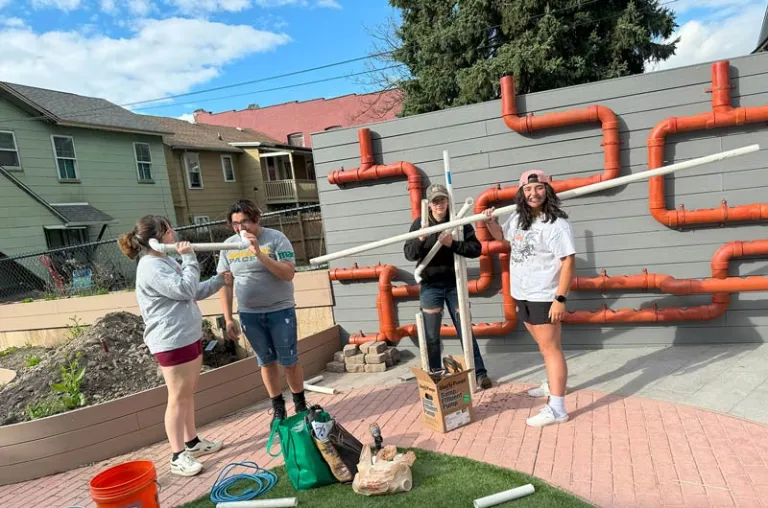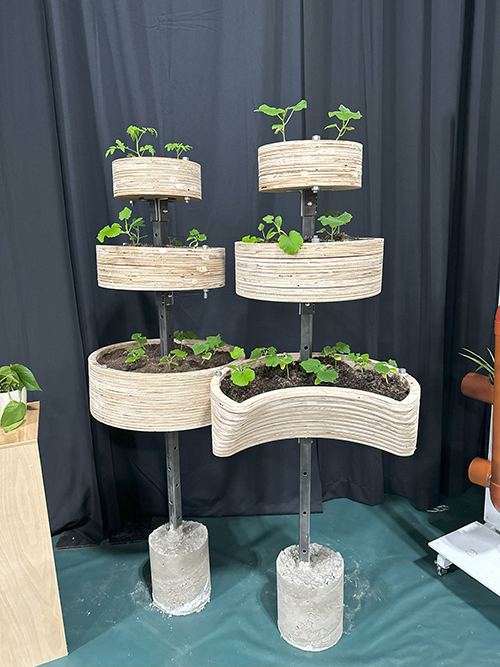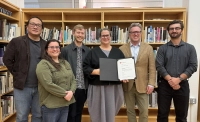
Marywood University Collaborates with Garden of Cedar on Community Garden Project: Public Unveiling Ceremony Is Set for May 15
Published
Marywood University is working in collaboration with the Garden of Cedar, a local nonprofit organization in Scranton's South Side neighborhood, on a community garden project that features sculpture, native plants, vertical planters, a hydroponic system, and other features to be added later.
All are welcome to attend a public unveiling ceremony of the space on May 15, at 5 p.m., at the Garden of Cedar, 715 Cedar Avenue, Scranton.
The specific academic areas involved with the project include the Environmental Science Program, Art Department, School of Architecture (SOA), and School of Business and Global Innovation (SBGI).
The living T-rail sculpture’s design ties to the area’s industrial roots, specifically highlighting the pivotal role of the Iron Furnaces in shaping the regional landscape. At the base of the sculpture, an arrangement of native vegetation is planned. This natural component is not only aesthetic but is also symbolic, designed to grow and intertwine around a representational map of Scranton. The sculpture was funded by Frank and Marigrace Dubas, Scranton, Michael and Candice Curran, New Canaan, CT, and Howard and Amy Kaplan, Saddle River, NJ.
Native plants were donated to the Garden for community members to plant in the garden or take back to plant in their yards, including Black-eyed Susans, Butterfly Weed, and Yellow Coneflower.
Vertical p lanters, inspired by the design of totem poles, provide accessibility for ADA planting as the planters are raised above the height of the ground-level planters already in the garden.
lanters, inspired by the design of totem poles, provide accessibility for ADA planting as the planters are raised above the height of the ground-level planters already in the garden.
A hydroponic system developed by the students uses sustainable methods of maintaining plant life on an existing vertical wall, providing not only a visual experience, but an interactive one, as users are given the opportunity to grow specific herbs and succulents on the site.
Features that will be installed in the Garden at a later date include bee hotels and a canopy. Bee hotels are the insect equivalent of a birdhouse, providing nesting spaces for solitary bees. Solitary bees, such as mason bees and leafcutter bees, are non-aggressive because they are solitary nesters and do not have large colonies to defend. Most bees native to Pennsylvania are in fact solitary bees, acting as important pollinators that are vital to the survival of our ecosystems. The canopy will be a removable shade structure to be used by outreach programs that provide lunches and other events to children during the hot summer months.
The Garden of Cedar was created and developed by Frank Dubas, President of the Garden. Frank is also responsible for the Garden’s unique design and construction. Marywood students, faculty, and staff have been collaborating with Frank on the project for several years. Branding, including the logo for the Garden, was created and developed by Marywood students. Tom McLean & Associates provided landscape design. Jerry Chilewski Enterprises constructed the Garden.
Principal faculty from Marywood University involved with the project include: Michelle Pannone, SBGI Executive Director & Associate Professor; Sara Melick, Assistant Professor of Practice in Environmental Science; Sue Jenkins, Associate Professor of Art and Design, and Christine Medley, Associate Professor of Graphic Design.
Students and recent graduates involved with the project include:
Environmental Science: Juan Cardenas, Emily Haggerty, Carly Walters, and Bailey White.
Graphic Design: Kristina Zenga, Marlena Bompane, Marykate Boyle, Danae Drews, Jad Tindall, Alexander Shields, Caitlinn Belcher, Emily Duris, Marla Gambucci, Reece Wolbert, Allison MacDermott, Shanon Sohl, Gabby Ziegler, and Daniele Cragle.
Architecture: Nicholas Baney, Kyle Brosenne, Giavanna Burdick, Brianna Conniff, Lois Downing, Iain Kerrigan, Daniel Leonard, Tristan Luczak, Thomas Milewski, Megan Pavlowski, Christopher Salisbury, Joseph Sanfilippo, Autumn Savitski, Angelika Valdes, and Lenae Burkhard.
Marketing: Kathleen Lynott.
Learn More:
-
.jpg/200w/99q) Marywood PA Program Brings Holiday Cheer Through Angel Tree Initiative
Marywood PA Program Brings Holiday Cheer Through Angel Tree InitiativeMarywood PA students and faculty, led by Haley Jupina, brought holiday cheer to 94 children through their first-ever Angel Tree initiative—demonstrating the program’s commitment to service and community.
-
 AIA Pennsylvania Honors School of Architecture with 2025 Social Impact Award
AIA Pennsylvania Honors School of Architecture with 2025 Social Impact AwardThis honor is part of the AIA Pennsylvania Architectural Excellence Special Awards program, which recognizes outstanding contributions by individuals, organizations, and institutions that advance the built environment and the architectural profession across the Commonwealth.
-
 Marywood University’s John Maurer to Perform National Anthem at Boston Celtics Game
Marywood University’s John Maurer to Perform National Anthem at Boston Celtics GameJohn Maurer to perform the national anthem at the Boston Celtics game in January